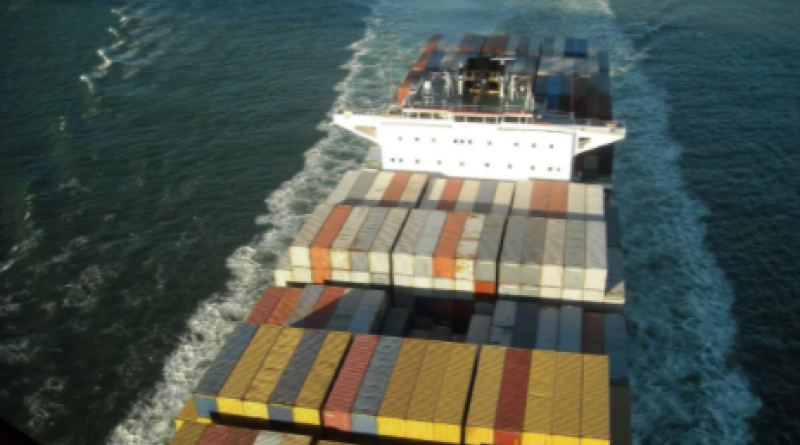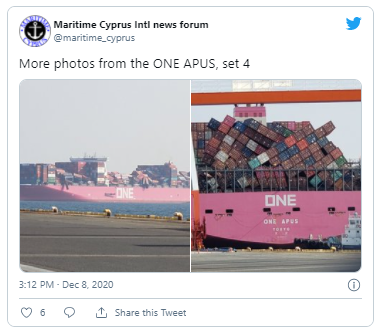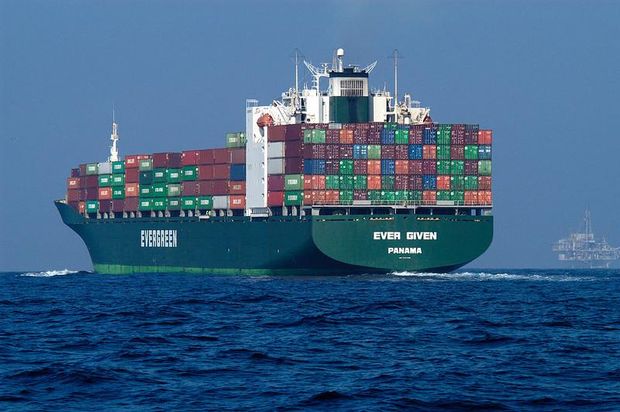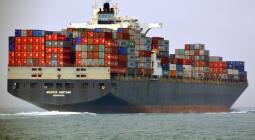3,000 Shipping Containers Fell Into the Pacific Ocean Last Winter.

You're right if you think you've been hearing a lot about container ships lately. One off the coast of Sri Lanka that was carrying 25 tons of nitric acid and other cargo suffered an explosion after containers caught fire on May 20 and burned for more than a week, littering the beaches with plastic pollution. And in March all eyes were on the Suez Canal, where a 1,300-foot-long container ship turned sideways and gummed up international trade with a six-day-long traffic jam. Maybe you've also had your shoes, bike or other online purchases delayed because of backed-up ports near Los Angeles.
But less attention surrounded a spate of container-ship accidents in the Pacific Ocean this past winter. It included one of the worst shipping accidents on record, which occurred near midnight on Nov. 30 as towering waves buffeted the ONE Apus, a 1,200-foot cargo ship delivering thousands of containers full of goods from China to Los Angeles. In remote waters 1,600 miles northwest of Hawai'i, the container stack lashed to the ship's deck collapsed, tossing more than 1,800 containers into the sea.
Some of those containers carried dangerous goods, including batteries, fireworks and liquid ethanol.
"This is a massive spill," says oceanographer Curt Ebbesmeyer, who has tracked marine debris from container spills for over 30 years. The ONE Apus lost more containers in a single night than the shipping industry reports are lost worldwide in an entire year.

It was also only one of at least six spills since October that dumped more than 3,000 cargo containers into the Pacific Ocean along shipping routes between Asia and the United States. They include the loss of 100 containers from the ONE Aquila on Oct. 30 and 750 containers from the Maersk Essen on Jan. 16. Both ships encountered rough weather while delivering goods to the United States.
Experts say these types of spills, which tend to fly under the public's radar, put containers into the sea that pose potential hazards to the health of the ocean and put everything from mariners to wildlife at risk.
"They're like time capsules of everything we buy and sell, sitting in the deep sea," says Andrew DeVogelaere, NOAA research coordinator at the Monterey Bay National Marine Sanctuary in California. Those lost containers may harm wildlife and ocean health, he says, by crushing aquatic habitats or introducing new seabed features that change biological communities or even aid the spread of invasive species. They can also release hazardous cargo such as the 6,000 pounds of sulfuric acid that went into the sea when the Maersk Shanghai lost containers off of the North Carolina coast in 2018.
Despite that potential for danger, no one is tracking the lost containers in the Pacific and opinions vary about where they will come to rest. Many are likely on the ocean floor, but an unknown number may have ruptured and disgorged their contents, which typically include many thousands of consumer items made of plastic. They could float for years in the ocean or wash ashore in Alaska, Hawai'i or other locations.
To date, the only debris known to come ashore from this winter's accidents are giant waterlogged sacks of chia seeds, which hit Oregon beaches in December following the loss of six containers from a ship near the California coast. Federal biologists were still cleaning smelly globs of the seeds from threatened snowy plover nesting habitat in April.
The accidents come at a time when the container shipping industry we all rely on is under unprecedented strain. In April the National Retail Federation reported a 10th consecutive month of record-high imports from Asia to the U.S. West Coast, driven by skyrocketing online shopping tied to the pandemic.
It's led to backed-up ports, delayed deliveries, and shortages of empty containers, conditions that are forecast to continue. But in a trick of the pandemic tied to both U.S. shopping patterns and Chinese factory schedules, it also put more cargo ships on the water during fall and winter, the stormiest time of year in the Pacific.
Some experts say the changes may represent a new normal for trans-Pacific container shipping. If that's true, more spills may lie ahead — prompting calls for greater transparency and accountability from shippers.
Decades of Debris
"I'm considered persona non grata by the shipping industry," Ebbesmeyer says when asked if he knew anything about what was aboard the ONE Apus or where it might be headed. "They blackballed me years ago. They didn't like me shining a light in a dark place."
That dark place is the inside of a shipping container. Back in the 1990s Ebbesmeyer began applying his oceanography skills to tracking debris from what seemed like an ever-increasing number of container accidents. One year it was 28,000 rubber bath toys shaped like ducks, beavers, turtles and frogs that spilled from a single container lost in the North Pacific. Another year it was 61,000 Nike sneakers from a handful of containers, also in the Pacific.
With a friend at the National Oceanographic and Atmospheric Administration, he calculated how far the flotsam would travel. Over close to a decade, beachcombers around the world confirmed their predictions with reports of debris from Texas to Australia to the United Kingdom.
"As an oceanographer, I want to know how the ocean works," Ebbesmeyer says. Following the debris helped him understand ocean currents and the destination of the marine debris that even by the 1990s was on the rise. But as Ebbesmeyer's work gained notoriety, he says the industry went mum. And what little light had been shed inside shipping containers flickered out.
But the accidents didn't stop. In 1997 a single container lost from a ship in near England spilled 5 million Lego pieces, which still wash ashore today.

In the early 2000s, it was computer monitors landing on beaches from California to Alaska. Ebbesmeyer says the shippers seldom disclosed how many items were lost, and he suspects the same silence will surround the ONE Apus and other recent spills.
"If they'd share what's in the containers," he says, "we might predict where the debris will land and possibly organize a response." Spilled goods travel the waters differently depending on their weight and materials; if the scientists know those details, they can anticipate where the products will eventually land. By tracking this trash, oceanographers could learn more about where currents and winds carry other debris, too. And, says Ebbesmeyer, it might compel shippers to help pay for cleanup, an expense coastal residents and agencies usually absorb today.
But shippers seem as tight-lipped as ever. Beyond reporting the presence of certain hazardous materials, they have not released details about the 3,000 missing containers.
Who's Minding the Ship?
According to the industry trade group the World Shipping Council, 6,000 container ships traverse the oceans every day, moving 226 million containers annually. The ships sail a dizzying array of routes among more than 200 ports and are registered in countries around the world. But because they spend much of their time on the high seas outside any one nation's jurisdiction, governance is a mix of regulations and voluntary best practices that don't require tracking or recovering debris from lost containers. That only happens when losses occur in nearshore waters where the United States or another country claims jurisdiction.

"We usually read about it in the news," says Catherine Berg, scientific support coordinator at NOAA's Emergency Response Division in Alaska. Berg says no formal mechanism is in place for reporting high-seas shipping container accidents like the ONE Apus to the U.S. government. And no funding exists for NOAA scientists to track the debris, although they occasionally perform informal modeling.
Officers with the U.S. Coast Guard Joint Rescue Coordination Center in Honolulu, Hawai'i, tell a similar story. They say shippers report container spills as a courtesy but that the agency lacks authority or funding to investigate, unless containers directly threaten U.S. shores. Instead, following the ONE Apus spill, the Coast Guard issued a notice to mariners about the hazard of floating containers, which some sailors call "steel icebergs" for their deceptively low profile on the water. The notice expired after a couple of weeks, with the assumption containers had sunk, ruptured or dispersed.
On the open seas, the shipping trade is primarily governed by the International Maritime Organization and other United Nations groups. Among their primary tools is the Safety of Life at Sea (SOLAS) treaty, originally signed in 1914. It was last amended in 2016 with new rules on weighing of containers, intended to lessen spills.
In 2014 the IMO also endorsed an updated code of practice for cargo ships, which addresses packing, stacking and lashing of containers. Although shippers frequently blame losses on rough weather, as happened in each of last winter's Pacific Ocean accidents, investigation often reveals underlying problems in lashing and other practices that occur before a ship even leaves port. That happened in May 2020 when the APL England lost 43 containers near Australia, forcing popular Sydney beaches to close as authorities cleaned a debris field of appliance parts, plastic boxes and face masks.
The updated code of practice is only voluntary and does not include provisions for tracking lost containers or revealing their contents. But continued cargo accidents may be forcing a change.
In 2019, when the MSC Zoe lost 280 containers in heavy weather between Portugal and Germany, volunteers and Dutch troops spent months cleaning Wadden Islands' shores of toys, furniture and smashed televisions. Following the accident, which investigators also blamed on poor lashing, the Council of the European Union submitted a draft proposal for a new IMO rule requiring better reporting of containers lost at sea. If passed, and depending on the rule's terms, it could one day address Ebbesmeyer's decades-long concerns over shipper transparency.
Also following the MSC Zoe, the Dutch government commissioned a review of shipping practices and technologies that could aid in tracking containers, including equipping them with satellite tags. Echoing Ebbesmeyer's experiences, the report said it is "hard to track down" what lies within lost containers and that improvement would require industry cooperation and investment.
Industry support may be gaining. The World Shipping Council, which has supported past amendments to SOLAS, is a cosponsor of the proposed new rule, according to the organization's spokesperson Anna Larsson.
"We really support all and any fact-based measures to improve safety," Larsson said in an email.
Environmental Cost
Although springtime's calmer weather has replaced the winter storms that battered cargo ships, it's likely whatever debris from recent spills that has not sunk to the bottom of the Pacific is still floating out there somewhere. But with so little known about the containers and their contents, it's unclear where the debris is headed.
"Just because you don't see it doesn't mean it's on the seafloor," says Ebbesmeyer.
He gives the example of a container full of plastic telephones in the likeness of the comic-strip cat Garfield that spilled from a ship along the European coast in the 1980s. For decades, cables and shards of orange plastic mysteriously washed ashore from the phones. The mangled container that once held them was finally discovered in 2019, wedged deep in a French sea cave that's underwater much of the year.
Thousands of other containers must lie on sea bottoms along the world's shipping routes, says NOAA's DeVogelaere.
In what is possibly the only study of its kind, DeVogelaere keeps his eye on a shipping container lying in 4,000 feet of water at the Monterey Bay sanctuary. It was one of 24 that toppled from a Taiwanese cargo ship in 2004 and was serendipitously discovered by one of NOAA's remotely operated vehicles conducting unrelated research. Since 2011, DeVogelaere has monitored ecological change around the container, noting colonization by species not typically found in the immediate area. This year his team will investigate whether the container's anti-corrosive paints, which can be toxic, may also have an ecological effect.
"We're impacting an environment that we haven't even begun to understand," he says of the seafloor.
DeVogelaere's container, which has so far remained latched shut, holds more than 1,100 steel-belted radial tires. He knows this only because it happened to land in a nearshore federal sanctuary, putting it under U.S. jurisdiction. Through a lengthy legal process, NOAA won a $3.25 million settlement from the shipper.
Such settlements take time but can occur when containers spill in nearshore waters. For instance, when the Hanjin Seattle lost 35 empty containers near Canada's west coast in 2016, officials won a modest settlement to help pay for removal of foam insulation that littered wildlife habitat along miles of national park and First Nations beaches.
After the Svendborg Maersk lost 517 containers in the Bay of Biscay in 2014, French officials ordered the company to map sunken containers to identify commercial fishing hazards. And a settlement following the 2011 wreck of the MV Rena in New Zealand, which also caused an oil spill, included cleanup of tiny plastic beads that still wash ashore today.
Those beads, like the Legos, computer monitors and Garfield phones, hint at the unknown contribution of container spills to marine plastic pollution, which is increasingly understood to harm birds, whales, fish and other animals through both ingestion and entanglement.
Although the World Shipping Council tracks cargo accidents, which it says lose an average of 1,382 containers annually, no one knows their true ecological impact.
But Ebbesmeyer remains concerned. He likens each spill to dumping a big box store into the ocean.
"That plastic never goes away," he says. "It drifts around in the water or flies overhead in the stomachs of seabirds. It haunts you over time."
Tim Lydon writes from Alaska on public-lands and conservation issues. He has worked on public lands for much of the past three decades, both as a guide and for land-management agencies, and is a founding member of the Prince William Sound Stewardship Foundation. His writing has most recently appeared in The Revelator, Yes Magazine, Hakai Magazine, The Hill, High Country News, and elsewhere.
June 2021
EcoWatch




